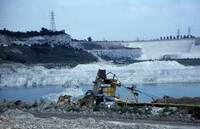- England
- Scotland
- France
- Holland
- Germany
- Italy
- Spain
- Portugal
- USA
- China
- Japan
- India
- Iran
- Advice
- Gardens
- England
- Scotland
- France
- Holland
- Germany
- Italy
- Spain
- Portugal
- USA
- China
- Japan
- India
- Iran
- Advice
- Garden Tours
Book: Landscape Planning and Environmental Impact Design: from EIA to EID
Chapter: Chapter 6 Mineral working, planning and design
The chalk and clay pits illustrate two points. First, as in the case of shortï¾life mines and quarries, the safest policy is to phase the issue of excavation permits and plan for 'continuous restoration'. Second, unanticipated afterï¾use possibilities may arise during the lifetime of the quarry. Restoration to the former use and contours is unimaginative and shortï¾sighted. Even in a simple strip mining operation it can be disruptive and expensive to reï¾transport overburden from the first cut, which may have lain in a dump for 30ï¾40 years, and use it to backfill the last cut. A wiser policy is to plan the whole workings to create a new landscape [Fig 6.10]. This can be done on a looseï¾fit basis to accommodate alternative afterï¾uses. If the final landscape is fertile, visually attractive, and has good access and drainage, it will be found suitable for a wide range of afterï¾uses. Planning an afterï¾use may result in shallower excavations and a larger land take, but the short term disturbance will be justified by the long term afterï¾use potential of the land (Ministry of Housing and Local Government 1960). Deep and dangerous pits should only be dug when a supply of filling material is assured. If quarries are left as cold, badly drained, flat areas surrounded by precipitous and unstable cliffs, they are likely to remain derelict for many decades after workings have ceased. Continuous restoration is an attractive concept but should not be conceived as a panacea to the reclamation problem. It implies a procedure by which minerals are won and land immediately put back to its preï¾mining condition. The planning merits of this procedure are twofold: it gives the local community a high degree of security against land dereliction and it appears to solve the afterï¾use question. Only a thin band of mineral is uncovered at any one time and it makes good economic sense to deposit the overburden material in a manner which facilitates an immediate return to the preï¾mining use. Deployment of very large excavating machines has increased the scope for strip mining and continuous restoration. The twin techniques are most common for shortï¾life operations but can sometimes be used in mediumï¾life projects. 'Progressive reclamation' is a better name for the procedure as it applies to mediumï¾life projects. 'Progressive' implies that each phase of the reclamation work may be of longer duration than justifies the description 'continuous'. 'Reclamation' implies that alternative land uses will be considered. Since mediumï¾life quarries are likely to be fully screened, the timing of the reclamation work is of less importance than the eventual achievement of a successful result. Overï¾hasty 'restoration' may limit the scope for innovation and may produce a physically and visually degraded version of the preï¾mining land use. It is better to embrace the opportunity which arises from the vast movement of materials and adapt the land to a new use, be it housing, industry, water storage, recreation, or a wholly unanticipated function. Many new uses cannot be established while mining proceeds and are incompatible with the goal of 'continuous restoration'. The objective should be to reclaim the land for the highest and best land use of which it is capable. The mining and reclamation of brown coal, near Cologne in West Germany, is a good example of a mining operation which has been divided into a series of phases, with progressive reclamation of the land to create a new landscape. The brown coal is worked by surface mining at depths of up to 320m in seams of up to 100m thickness. Giant bucket�wheel excavators are able to move 200,000 m3 per day [Fig 6.11]. When the Hambach Mine was opened, the first cut produced 2.7 billion m3 of overburden which had to be deposited outside the mine. Approximately 1.7 billion m3 was used to fill old mines and 1.0 billion m3 was used to make a new mountain. Since there is no possibility of 'restoring' the land every effort is made to create a new landscape. Villages, roads and railways are destroyed and rebuilt in new places. This has to be done progressively so that farmers and villagers have somewhere to go when the land beneath their old homes is removed. They consent because the browncoal authority has proved its ability to create new landscapes. The oldest reclaimed area, near Br�hl, has been sculptured into a new landscape with over 1,200 hectares of forests and lakes [Fig 6.12]. It has considerable charm and attracts large numbers of visitors from Br�hl and nearby towns. Mining and planning are regulated by the 1950 Law for Overall Planning in the Rhineland Brown Coal Area (Leuschner 1976).
